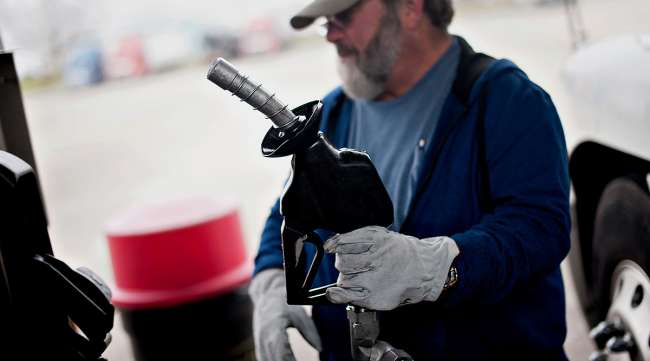Staff Reporter
Diesel Slips 0.1¢ to $3.050 a Gallon

[Stay on top of transportation news: Get TTNews in your inbox.]
The U.S. average retail price of diesel dropped by 0.1 cent to $3.050 a gallon, the Department of Energy reported Oct. 21. Trucking’s main fuel costs 33 cents less than it did a year ago, when it was $3.38, according to DOE.
Half of U.S. regions saw the average price decrease, with the biggest decline occurring in the Midwest — 1 cent to $2.957 per gallon.
The West Coast saw the largest jump, 2.2 cents to $3.675 per gallon.
U.S. average #diesel fuel price on 10/21/2019 was $3.050/gal, DOWN 0.1¢/gallon from 10/14/19, DOWN 33.0¢/gallon from year ago https://t.co/hxGzwKMtUv #truckers #shippers #fuelprices pic.twitter.com/YnUHzkP8OC — EIA (@EIAgov) October 22, 2019
The average price of a gallon of gasoline, meanwhile, climbed 0.9 cent to $2.638, which still is 20.3 cents cheaper than a year ago.
U.S. average price for regular-grade #gasoline on 10/21/2019 was $2.638/gal, UP 0.9¢/gallon from 10/14/19, DOWN 20.3¢/gallon from year ago https://t.co/5shzy0OGMc #gasprices pic.twitter.com/QJxFLMP7qi — EIA (@EIAgov) October 22, 2019
On the world markets, oil surged in the biggest gain since the attack on Saudi Arabian fuel facilities in mid-September.
West Texas Intermediate for December delivery added $1.49 to close at $55.97 on Oct. 23, the biggest gain since Sept. 16, according to Bloomberg News. Brent for December settlement rose $1.47 to $61.17 on the same day. The global benchmark crude traded at a $5.35 premium to WTI.
The rally was driven in part by a surprise draw on U.S. oil inventories. Total U.S. stockpiles of crude and petroleum products, excluding the strategic petroleum reserve, fell by 9 million barrels to the lowest level since May, according to Bloomberg News. Gasoline inventories dropped for a fourth week as demand for the motor fuel rose to its highest since at least 1991 on a seasonal basis, Bloomberg News reported.
“It was a pretty solid day for oil prices,” said Denton Cinquegrana, chief oil analyst for the Oil Price Information Service. “Part of the reason is you had an [inventory] drawdown.”

Cinquegrana
Cinquegrana told Transport Topics oil traders are bidding up the cost of petroleum because they see two factors related to U.S. oil supply.
One, exports of U.S. crude oil are the highest ever, Cinquegrana said, with the United States often competing with Saudi Arabia as the world’s top exporter. The exports have stimulated U.S. refining, with crude oil inputs averaging 15.9 million barrels per day during the week ending Oct. 18, 2019 — 429,000 barrels per day more than the previous week’s average, according to DOE.
Two, imports of oil to the United States are low — fewer than 6 million barrels a day. Lower imports mean the U.S. supply is not being supplemented. The low import level is unusual, he said.
“That’s only happened four times this decade,” Cinquegrana said.
And with a major change to shipping-fuel refining coming Jan. 1, consumers could see prices inch higher, as U.S. and world refineries scramble to meet demand for new bunker fuel for ships — a fuel with less sulfur, as mandated by the International Maritime Organization.
With diesel prices uncertain and idling a major cost headache for fleets, one Florida firm offers a solution: analysis of when Class 8 tractors need to be retired.
Fleet Advantage of Fort Lauderdale consults with trucking fleets about their Class 8 tractors. A solution the firm offers to reduce fuel costs often is surprising: replacement. A new truck could mean more than $6,000 in the first year’s fuel savings, according to Brett Wilkie, Fleet Advantage senior director of fleet services.
Wilkie told TT that the company’s general analysis shows that replacing 100 trucks built in 2015, using 2020 models, would mean $1.7 million in fuel savings in the first year. That’s because truck manufacturers have been encouraged by the federal government to reduce emissions and improve miles per gallon. The newer technology makes fuel savings, and replacement, attractive, he said.

Wilkie
Wilkie added that he encourages fleets to replace trucks when they are “economically obsolete,” not when they are physically obsolete. The best way to reduce fuel costs, he said, is to reduce the life cycles of Class 8 trucks.
Fleet Advantage works by looking at a company’s own data, Wilkie said. Analysis is done, and it usually shows older trucks, even trucks produced as recently as 2015, using more diesel than is necessary.
Currently, Fleet Advantage has access to fleets’ data on 15 billion miles, Wilkie said. The data is passed on from trucking companies to Fleet Advantage using the trucks’ onboard computers. The data is analyzed, and the Florida firm then advises fleets on what types of new trucks to lease.
There is no one favorite model, Wilkie said, because trucking companies differ. Some fleets ride over differing terrains, some do not. Some trucking firms have regular routes, others do not. Wilkie said he helps fleets look at the best new trucks with the latest technology.
He said a model’s first year usually is the best year for diesel savings because of degradation of fuel systems. Even so, the data Wilkie shows fleets often wins over the skeptics, he said.
Want more news? Listen to today's daily briefing:




